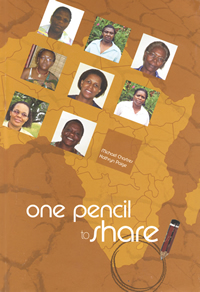|
Yvonne Reed of the Department of Applied Language at the University of the Witwatersrand reviews a new book on stories on Eastern Cape teacher transformation in the field of Science and Mathematics .
Chartres , M. & Paige, K. (2005) one pencil to share: stories of teacher transformation in Science and Mathematics from the Eastern Cape , Republic of South Africa . Adelaide : Post Pressed ISBN: 1 876682 72 1
The back cover blurb for Emerging Voices (2005), a report on education in South African rural communities commissioned by the Nelson Mandela Foundation, begins on a somewhat pessimistic note with the following statement:
This book graphically illustrates the conditions that make the dreams of a better life for all virtually unrealizable in rural areas.
While the title one pencil to share also foregrounds the pervasiveness of rural poverty and the continuing legacies of apartheid-era inequality of educational provision, this book celebrates the resourcefulness of learners and of teachers. The teachers whose stories are told are former students of the University of Fort Hare's distance learning, in-service B Prim Ed programme. The authors describe the incident that inspired the book's title:
On one memorable occasion we noticed a group of nine students participating in a group activity. We watched as one learner wrote and the others waited patiently for their turn to write. It was then we realised they had one pencil to share (2005:1).
Michael Chartres and Kathryn Paige are Mathematics and Science educators from the University of South Australia who collaborated with colleagues at the University of Fort Hare in the design and implementation of the B Prim Ed programme. While based in South Africa, they collected stories of Eastern Cape rural and township teachers through a sequence of initial interview, classroom observations and follow-up interview. After they had written the stories of eight primary school teachers they invited these women to comment on, suggest changes to the manuscript, and to write captions to the many colour photographs which are integral to the textured representation of their professional development. One of the pleasures of reading the book that resulted from this collaborative process is that of ‘listening' to authentic teacher voices.
Each of the eight stories includes information (print and visual) about a school and its context, an account of aspects of a teacher's personal and professional journey, her reflections on the University of Fort Hare programme, an account of aspects of her changing classroom practices and, in some cases, her thoughts about the future. After each story there is a brief commentary from the authors.
Chartres and Paige describe each story as unique but also as contributing to an account of ‘many aspects of professional transformation, including the struggles involved in change, the development of deeper educational philosophy and new values, classroom practices and ways of integrating schools with their communities' (2005:8). I agree with their observation that while the stories primarily focus on teaching science and mathematics, the approaches the teachers take in order to engage learners' interest are applicable across the curriculum. The teachers' accounts of their work and the photographs of classroom libraries in action, of musical instruments made from waste materials, of learners participating purposefully in group activities and of school gardens (to list just a few examples) offer inspiration to all teachers. In the words of Chartres and Paige, the stories and photographs in one pencil to share ‘not only demonstrate new approaches to teaching and learning but also signal hope and possibility for the future of schools, learners and their communities' (2005:8 ).
|

